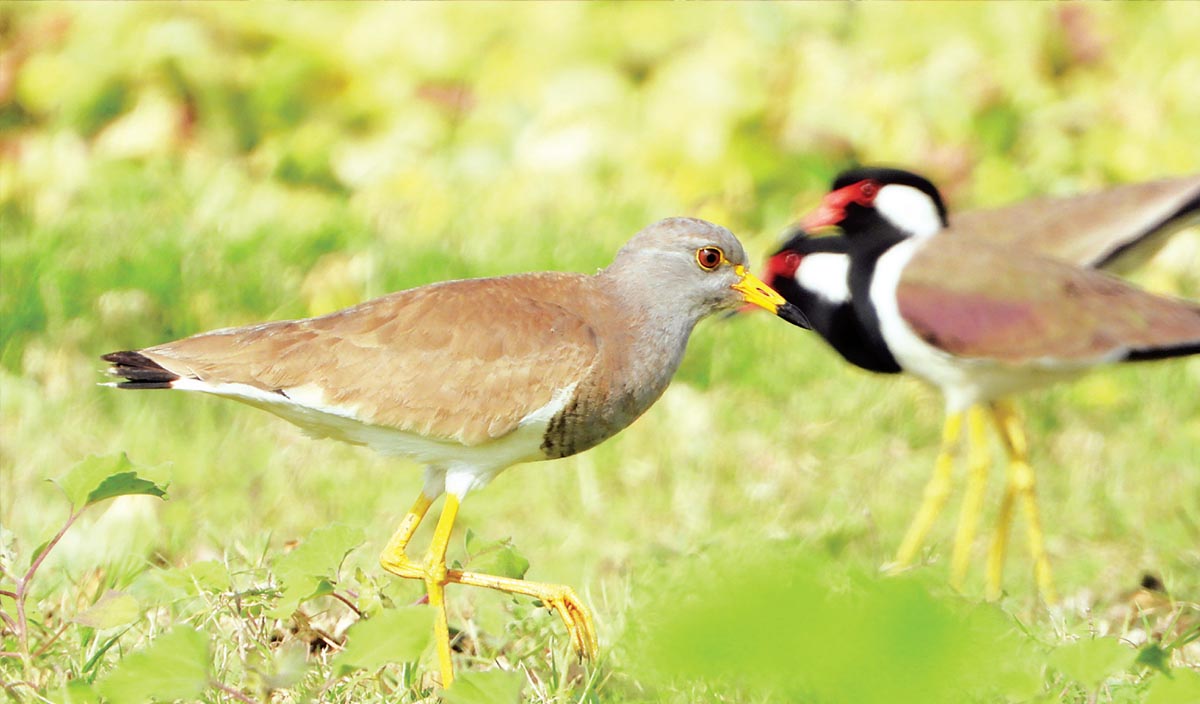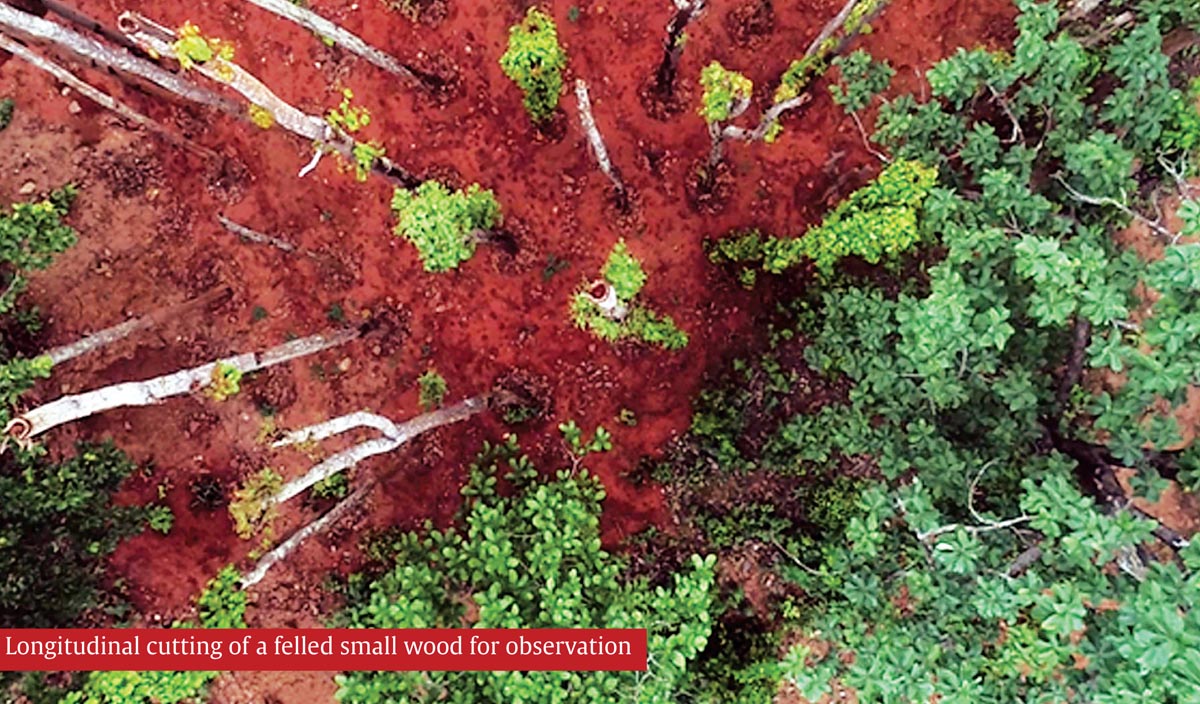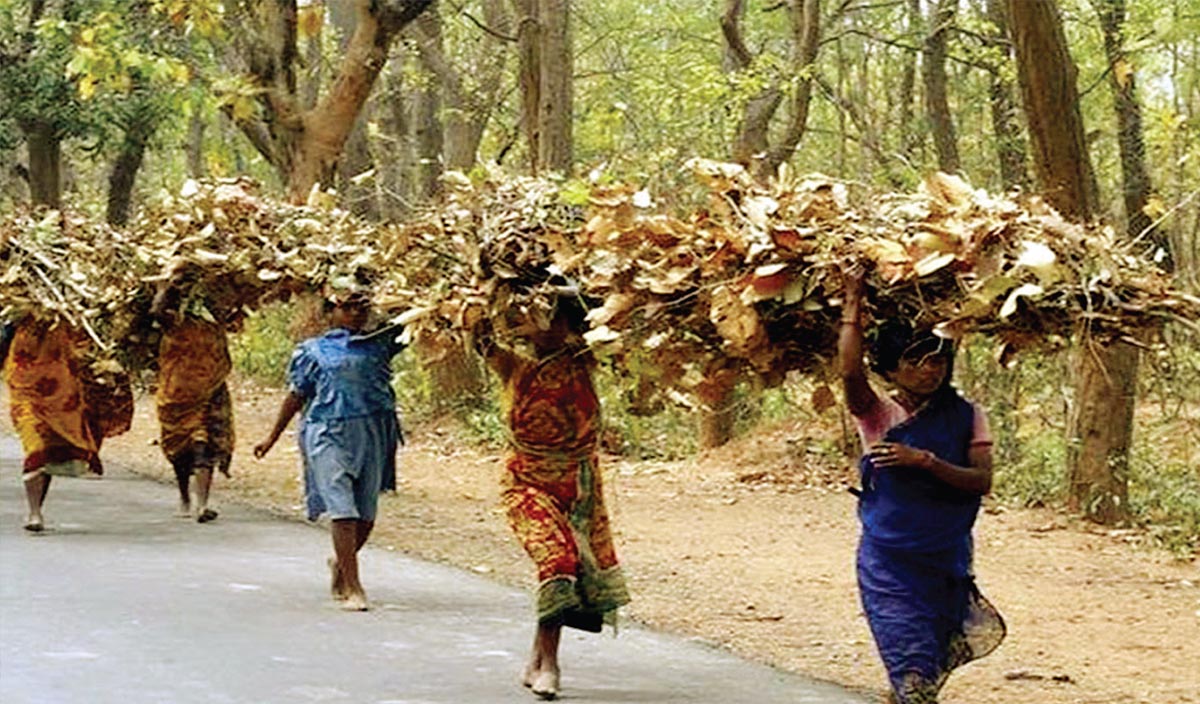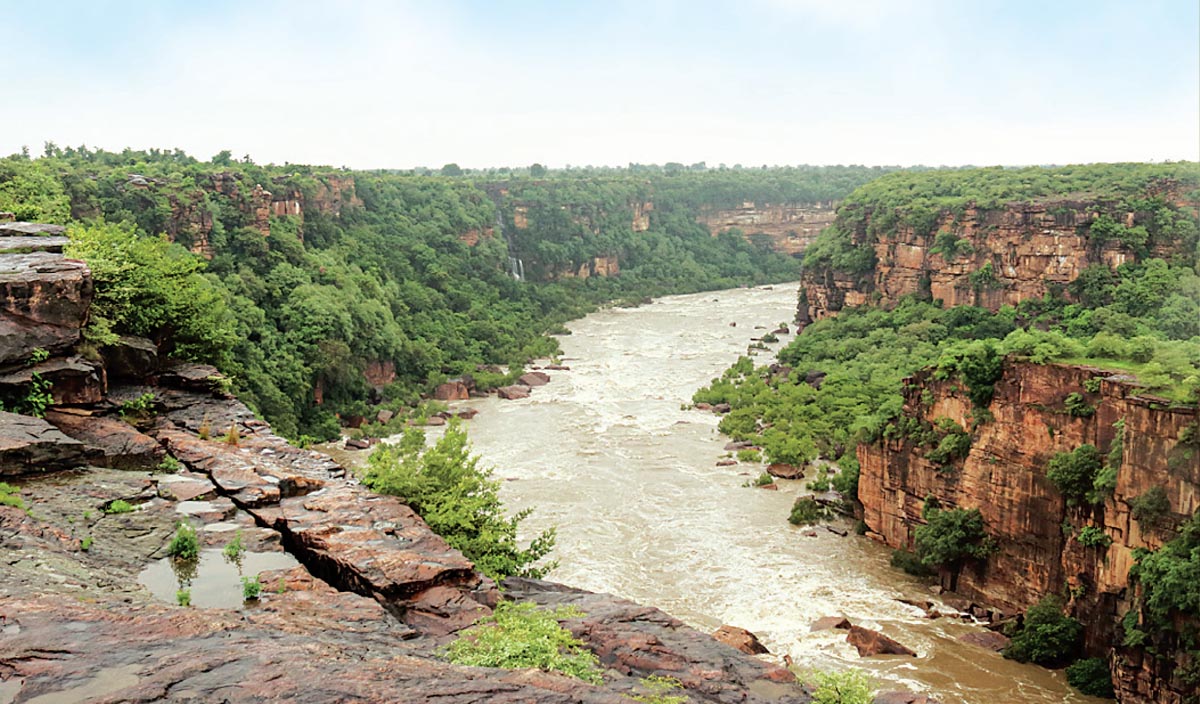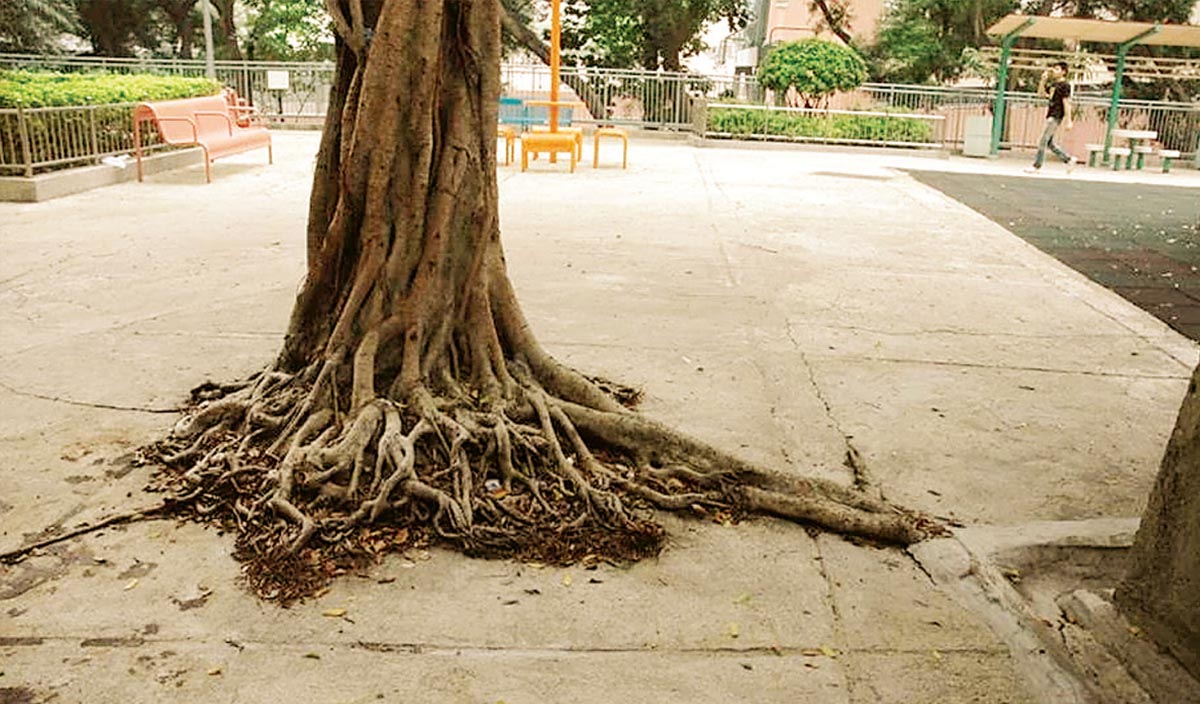
Strangulation by cementing is the silent
killer of trees in urban environments
By Sundararaj R, Swetha P, Padma S and Narasimhamurthy
Abstract: Urban trees are essential for maintaining ecological balance, improving air quality, and enhancing the aesthetic value of cities. However, urbanization often neglects the health of trees, causing colossal damage to the environment. This paper presents a comprehensive survey conducted in Bangalore, India, examining the effects of close cementing around tree collars of roadside trees at ground level. The observation reveals that close cementing not only impedes critical processes such as water infiltration and nutrient absorption but also permanently hinders natural growth and suffocates the trees, leading to growth and drought stress, which in turn causes the drying of branches from the top and ultimately results in the death of the trees. Thus, close cementing around the trees simulates strangulation and silently kills them. The findings highlight the urgent need for revised urban planning practices that prioritize tree health and sustainability. Recommendations include enforcing policies to restrict cementing around tree bases, leaving a free zone of at least one to two foot around the trees, and using only permeable materials at one more foot beyond the free zone. It is critical to raise awareness so that people perceive trees as soulful, living things rather than simply silent objects that commit injustice. Adoption of these measures into urban development strategies will support the health and longevity of urban trees by fostering more resilient and sustainable urban environments.
Keywords: Cementing. Strangulation, longevity of trees
INTRODUCTION
Trees are an important component of the urban environment because they play a major role in improving a city’s air quality by absorbing and concentrating pollutants, increasing aesthetic value, reducing the need for air conditioning, and reducing the use of fossil fuels for sustainable living (Daniel & Charles, 1992). They are indispensable to the urban environment, offering a range of ecological, social, and economic benefits that are crucial for the sustainability and livability of cities. They make a significant contribution to reducing the urban heat island effect, a phenomenon in which human activity and infrastructure raise urban temperatures relative to surrounding rural areas. By providing shade and facilitating evapotranspiration, trees help to lower ambient temperatures, making urban areas more comfortable, particularly during extreme heat events (Gill et al., 2007; Bowler et al., 2010). Also, apparently the high canopy of street trees is associated with fewer accidents by reducing the glaring effect of the sun. In addition to regulating temperatures, urban trees contribute significantly to improving air quality.
They absorb pollutants such as carbon dioxide (CO₂), sulfur-dioxide (SO₂), nitrogen oxides (NOx), and particulate matter, thereby reducing overall pollution levels and enhancing public health (Nowak et al., 2006). Furthermore, urban trees act as carbon sinks, sequestering carbon and mitigating climate change by lowering greenhouse gas concentrations in the atmosphere (McPherson et al., 1997). They also play a vital role in soil stabilization and erosion prevention, which is particularly important in areas prone to heavy rainfall and landslides. Their root systems help bind soil, reduce runoff, and maintain soil structure, thereby preventing erosion (Perry et al., 2008). Beyond these ecological functions, trees enhance the aesthetic value of urban areas, provide habitat for wildlife, and offer recreational spaces for residents, contributing to the overall quality of life in cities (Tyrväinen et al., 2005).
Despite these numerous benefits, urbanization and infrastructure development have often progressed at the expense of urban tree welfare. Rapid urban expansion in many Indian cities has prioritized human convenience and infrastructure over tree health. The widespread cementing and paving around the trees is a particularly harmful practice. While cement and concrete offer durability and ease of maintenance for sidewalks and roads, they create significant barriers to essential resources needed for tree survival and growth. Cementing disrupts the natural soil environment by preventing water infiltration, a critical process for water and nutrient absorption. The impermeable cement layer leads to soil compaction, reducing the soil’s ability to retain moisture and suffocating tree roots. Consequently, trees experience drought stress, weakened root systems, poor growth, reduced canopy cover, and increased disease susceptibility. Over time, these factors contribute to the gradual decline and eventual death of trees (Bhattacharya et al., 2015; Kumar et al., 2016; Sundararaj et al., 2019; Swetha & Padma, 2020). Given the critical role that trees play in urban ecosystems, it is essential to re-evaluate urban planning and infrastructure development practices to prioritize the health and longevity of urban trees.
MATERIALS AND METHODS
We conducted an extensive survey on roadside trees in urban areas of Bangalore, focusing on the impact of cementing on the health and longevity of trees. The study investigated how cementing and pavement construction around tree bases affect tree health and natural tree growth, as well as its implications.
RESULTS AND DISCUSSION
The survey across Bangalore’s urban areas revealed that the practice of cementing around tree roots significantly impairs tree health. By preventing water percolation and impeding their natural growth, cement layers create drought stress and root damage, leading to a gradual decline in the health and virulence of affected trees (Fig. 1). The study classified the four-stage progression of symptoms in trees subjected to cementing or pavement construction around their basal trunk as follows:
Stage 1: Initial Symptoms (Bulging at the basal part of the trunk and development of cracks in the surroundings) Trees initially show signs of stress, such as bulging at the base and exerting pressure against cemented areas/stones/tiles (Fig. 2).
Stage 2: (Drying from the Top and end of the branches) Trees show signs of stress, such as drying tips or uppermost branches. This early-stage symptom was often an indicator of restricted aeration and intake of water and nutrients (Fig. 3).
Stage 3: (Partial Deterioration) As stress continued, trees underwent partial deterioration, making them vulnerable to bio-deteriorating agents, as evidenced by a noticeable decline in overall vigour, reduced foliage density, and chlorosis. The tree’s structural integrity suffered during this stage, but some parts continued to function (Fig. 4).
Stage 4: (Death of trees) In this advanced stage, trees experience total canopy collapse and severe dieback. The majority of the tree’s biomass was either dead or in an irreversible state of decay, and ultimately the tree dies (Fig. 5). Therefore, the overall effect of close cementing simulates the strangulation of a tree by a nylon rope or iron wire, thereby silently causing its death (Fig. 6). The collected data revealed thqt more than 90% of the trees in Bangalore urban district are in different levels of strangulation by the cementing practices.
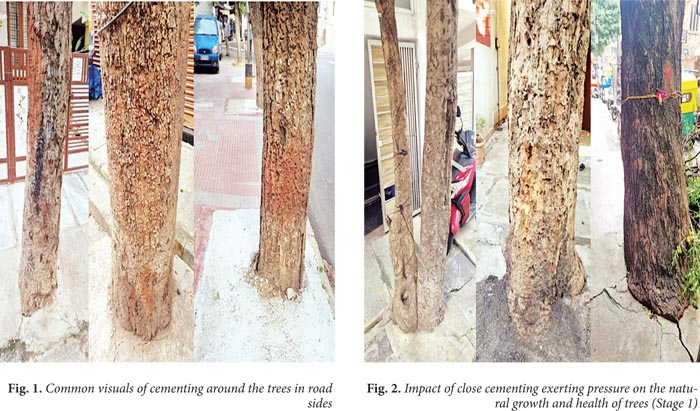
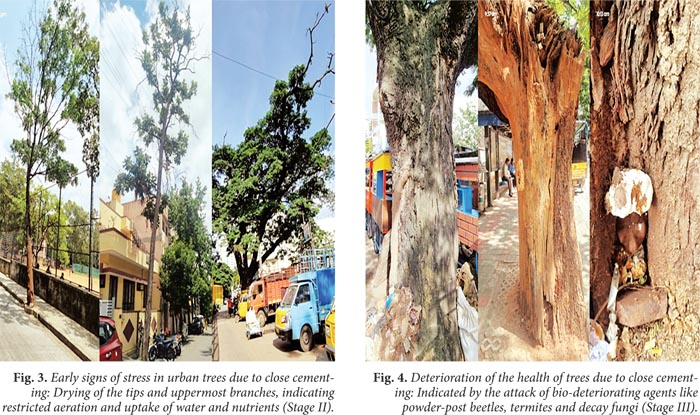
The survey noted that the impact of cementing not only affected individual tree health but also had broader environmental consequences. Cementing practices often led to structural weaknesses, contributing to the eventual death of many trees (Raj & Sinha, 2018; Varma et al., 2022). Areas with extensive cementing around trees were found to contribute to soil erosion and increased risk of landslides, as seen in the recent Wayanad landslide incident, partially attributed to the compromised ability of trees to anchor soil effectively (Kumar & Yadav, 2023; Patel et al., 2023). As observed, cementing or paving around tree bases creates a sealed surface that severely restricts the essential processes. This phenomenon was particularly evident in trees exhibiting poor growth, reduced canopy cover, and increased susceptibility to diseases (Gupta et al., 2020; Reddy & Kumar, 2021; Sundararaj et al., 2019; Swetha and Padma, 2020). This practice leads to symptoms of drought stress and eventual tree mortality, which manifest in stages of deterioration, from tip drying (Stage 1) to complete tree death (Stage 4).
Trees’ inability to access water and nutrients due to the impervious layers of cement results in a weakened root system, making them more susceptible to diseases and structural failure. These findings align with previous studies that have shown similar outcomes in trees subjected to poor urban planning practices (Gupta et al., 2020; Reddy & Kumar, 2021). In addition, the survey revealed that such trees, deprived of adequate root space, also suffered from reduced canopy cover, which further decreased their ability to photosynthesize effectively, compounding their decline. Man-made physical damages intensify the decline in trees exposed to cementing practices (Singh & Singh, 2017; Sharma et al., 2019).The article from “The Indian Express” also expressed the brutality of mankind toward urban trees, suffocating them through cementation. It mentioned that while older trees with deeper roots can survive, younger trees would die due to drying out. The famous poet Gieve Patel stated in his poem “On Killing a Tree” that “it takes much time to kill a tree,” but unfortunately, urban people have reinterpreted this statement by causing a giant tree to fall during a slight rainy night (The New Indian Express, 2024).
Furthermore, the practice of numbering trees by removing the bark completely ignores the damage it causes. The impact of such damage on trees can vary depending on the species and their level of resistance to wood-deteriorating agents. However, over time, the trees become more susceptible to biodegrading agents and the hollowing of the main stem, leading to their fall (Sundararaj & Rajarishi, 2023). A study on the health status and mortality of Neem trees revealed that human insensitivity and insouciance, manifested through pruning, pavements, enclosures, concretization, and damage to the bark and stem from nailing and stapling, were the main causes of tree death. This, in turn, completely undermined the concept of sustainable and conservation practices for avenue trees (Sundararaj et al., 2024). The practice of cementing around urban trees not only threatens the longevity and health of individual trees but also has far-reaching consequences for the urban ecosystem as a whole.
Trees play a vital role in sequestering carbon, mitigating urban heat islands, and improving air quality. By compromising their health through harmful practices, cities risk losing the benefits provided by healthy, mature trees. Thus, we need to focus on achieving optimum conditions and sustainable practices by ameliorating some of these deleterious practices through a better understanding of tree physiology (Mullaney et al., 2015; Shibata & Tan, 2022). According to Ferrini et al. (2020), a suitable sustainable growth of urban greenery and trees is crucial for supporting, regulating, and providing ecological services to mitigate the deleterious effects of urbanization on humankind. This reinforces the need for sustainable urban planning and tree management strategies that promote permeable surfaces, adequate soil space, and tree-friendly infrastructure.
The survey underscores the critical importance of adopting sustainable urban planning practices that prioritize tree health. Urban planners, policymakers, and communities must recognize the detrimental effects of cement and collaborate to implement practices that allow trees to thrive, contributing to a healthier and more resilient urban ecosystem (Sundararaj et al., 2019; Swetha & Padma, 2020) and ameliorating some of these stressors through a better understanding of the optimal environmental growing conditions for trees, tree physiology, and the needed technological and design interventions.
CONCLUSION
In conclusion, close cementing strangulates the trees and poses a threat to urban green spaces. Hence, the study underscores the urgent need for policy interventions and the adoption of tree-friendly urban planning practices to mitigate these adverse effects and prevent the desertification of urban environments. To effectively mitigate the adverse effects of cementing around urban trees, it is essential to implement a comprehensive set of remedies and policies that prioritize tree health in urban environments. The following recommendations provide a robust approach to addressing these challenges:
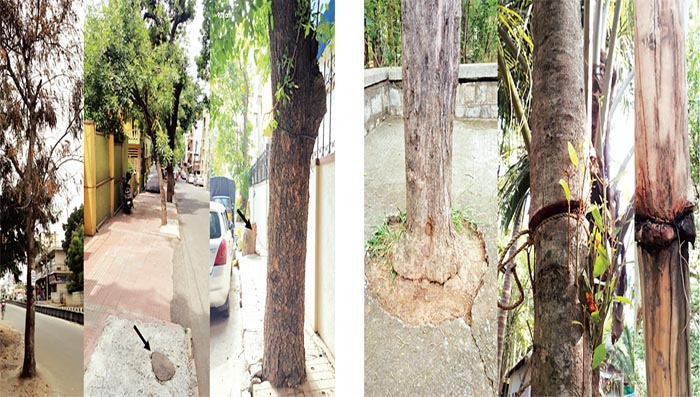
- Tree Protection Measures: Authorities should enforce strict regulations that prohibit the practice of cementing within a 1-2-foot radius depending on the trunk around the base of trees. This buffer zone is crucial to allow adequate water percolation, root aeration, and nutrient exchange. Policies should also promote the use of permeable materials for pavements, such as permeable concrete, gravel, or other porous surfaces, which allow water to reach the root zones (Prasad et al., 2019). Establish regular monitoring and compliance checks to ensure adherence to these regulations.
- Public Awareness: Increased public awareness is critical to the success of these policies. We should launch educational campaigns to educate citizens about the crucial role of trees in urban ecosystems and the detrimental effects of improper cementing practices. We can encourage public participation by involving community members in tree care activities like mulching, watering, and inspecting for encroaching pavements. Additionally, workshops and informational sessions can educate the public on how to identify and report issues related to tree health and protection. Movement Against Cruelty to Trees (MACT) is the need of the hour to safeguard the urban trees.
- Urban Planning: Integrating tree health considerations into urban planning is essential for creating sustainable cities. Urban development projects should be designed with tree-friendly infrastructure that avoids encroaching on root zones. Developers and urban planners should collaborate with arborists and environmental experts to ensure that new constructions are planned in a manner that supports the long-term health of urban trees. Green spaces should be strategically designed to include tree clusters with adequate open soil, promoting natural water infiltration and reducing the urban heat island effect. Hence, for improvement of the existing situations, “Root free movement” will boost the health and survival of urban trees.
- Scientific approach for street tree design: It is crucial to consider local trees and the design of the planting site. The planting site should be more spacious, situated in appropriate soil with proper soil porosity; good drainage and irrigation are essential. The tree’s full potential to grow is completely dependent on the type and volume of soil. A well-planned engineer overseeing the plantation would promote the growth and development of urban trees, while minimizing the destruction and loss of street trees. Therefore, choosing the right trees for the plantation, planning the site and infrastructure, and implementing the plan with scientific engineering is the preferred approach.
By implementing these measures, urban areas can better support the health and longevity of their trees, thereby contributing to a more sustainable and resilient urban environment as well as preventing it from desertification. Trees are invaluable assets to cities, providing ecological, social, and economic benefits. Thus, caring for their health through thoughtful policies and practices is essential for urban populations and the environment.
REFERENCES
Bhattacharya, A., Sharma, S., Patel, R. (2015). Urban Trees and Their Health: A Study of Cementing Effects. Journal of Environmental Management, 151, 290-298.
Bowler, D. E., Buyung-Ali, L., Knight, T. M., Pullin, A. S. (2010). Urban Greening to Cool Towns and Cities: A Systematic Review of the Empirical Evidence. Landscape and Urban Planning, 97(3), 147-155.
Ferrini, F., Fini, A., Mori, J., Gori, A. (2020). Role of vegetation as a mitigating factor in the urban context. Sustainability, 12(10), p.4247.
Gill, S. E., Handley, J. F., Ennos, A. R., Pauleit, S. (2007). Adapting Cities for Climate Change: The Role of the Green Infrastructure. Built Environment, 33(1), 115-133.
Gupta, R., Sharma, S., Patel, D. (2020). Water Percolation Issues in Urban Tree Pits. Journal of Urban Planning, 48(4), 325-333.
The New Indian Express. Don’t kill trees with concrete at the base – This ensures that the water table remains high and trees healthy. Accessed on 14th of Sep, 2024. https://www.newindianexpress. com/editorials/2024/Jun/11/dontkill-trees-with-concrete-at-the-base.
Kumar, A., Sinha, M., Gupta, A. (2016). The Impact of Urban Paving on Tree Health. Ecological Studies, 56(2), 214-220.
Kumar, S., Yadav, R. (2023). Soil Erosion and Urban Trees: Insights from Recent Landslide Events. Environmental Research Letters, 18(5), 511-520.
McPherson, E. G., Nowak, D. J., Rowntree, R. A. (1997). Quantifying Urban Forest Structure, Function, and Value: The Chicago Urban Forest Climate Project. Urban Ecosystems, 1(1), 49-61.
Mullaney, J., Lucke, T., Trueman, S. J. (2015). A review of benefits and challenges in growing street trees in paved urban environments. Landscape and Urban Planning, 134, 157–166.
Nowak, D. J., Crane, D. E., Stevens, J. C. (2006). Air Pollution Removal by Urban Trees and Shrubs in the United States. Urban Forestry & Urban Greening, 4(3-4), 115-123.
Patel, D., Sharma, A., Kumar, P. (2023). Tree Health and Landslide Risks: Case Studies and Analysis. Journal of Environmental Protection, 14(1), 45-59.
Perry, T. D., Jones, J. A., McDonnell, J. J. (2008). The Effects of Tree Removal on Soil and Water Quality in the Pacific Northwest. Journal of Hydrology, 358(3-4), 233-246.
Prasad, V., Sinha, M., Gupta, R. (2019). Policy Measures for Urban Tree Protection. Journal of Urban Affairs, 47(6), 789-800.
Raj, P., & Sinha, S. (2018). The Effects of Strangulation on Tree Health: A Comprehensive Review. Tree Physiology, 38(9), 1431-1440.
Rao, N., Kumar, R., Verma, M. (2020). Effective Tree Protection Strategies in Urban Areas. Urban Forestry & Urban Greening, 50, 84-93.
Reddy, S., Kumar, V. (2021). Assessing the Effects of Urbanization on Roadside Trees. Environmental Impact Assessment Review, 82, 106-115.
Sharma, A., Bhattacharya, P., Verma, M. (2019). Barbed Wire and Tree Health: An Urban Perspective. Urban Forestry & Urban Greening, 42, 124-132.
Shibata, S., Tan, P. Y. (2022). Assessing urban park street tree ecosystem services and their influence on residents’ well-being. Urban Forestry & Urban Greening, 69:127568.
Singh, P., Singh, R. (2017). Strangulation of Urban Trees: Causes and Consequences. Forestry Research, 72(1), 45-52.
Sundararaj, R., Mondal, S., Kanthareddy, M. (2019). Pruning Effects on the Health of Indian Sandalwood (Santalum album Linn) in Agroforestry Conditions of South India. American Journal of Plant Biology, 4(1), 1-6.
Sundararaj, R., Rajarishi, R. (2023). Impact of removing the bark of trees for numbering on the health & longevity of Trees. March-May, 2023 ed. SNHC Journal.
Sundararaj, R., Nagappa Manjula, K., Swetha, P., Gowda K.N., Padma, S. (2024). Insensitiveness of human beings is a major challenge to the sustainable management of bio-resources: A case study on the mortality of neem (Azadirachta indica L.) in South India. Forestist, 74(2), 198-210.
Swetha, P., Padma, S. (2020). Anthropogenic activities and rapid urbanization hampering carbon sequestration potential of urban trees. International Virtual Conference on Environmental Impact Assessment (IVCEIA-2020). In: Book of Abstracts and Proceedings Organized by Environment Information System (ENVIS) and Environmental Management and Policy Research Institute (EMPRI); 1st December 2020; Bengaluru, p. 49-54.
Tyrväinen, L., Mäkinen, K., Schipperijn, J. (2005). Tools for Mapping Social Values of Urban Woodlands and Other Green Areas. Landscape and Urban Planning, 79(1), 5-19.
Varma, A., Patel, R., Yadav, S. (2022). Barbed Wire Damage to Urban Trees: A Study in Southern India. Journal Arboriculture, 48(2), 215-223.
Related Posts
Guardians of Grey Headed
Guardians of Grey Headed Observations by CA. Shomi Gupta & Yogesh More The Grey Headed…
Tree Translocation of 1000 trees in Balliguda Forest Division
Tree Translocation of 1000 trees in Balliguda Forest Division By Vishwanath Neelannavar, IFS As per…
Participation of women in Natural Resource Management
Participation of women in Natural Resource Management By Anubha Srivastav and Anita Tomar Natural Resource…
Vulture – A lost magnificence
Vulture – A lost magnificence By Nitish Agrawal Madhya Pradesh has a rich diversity of…

